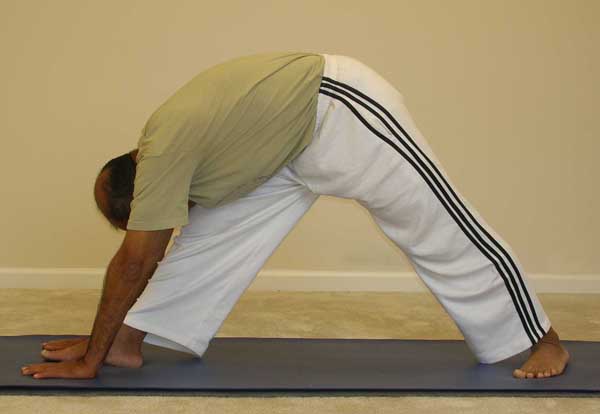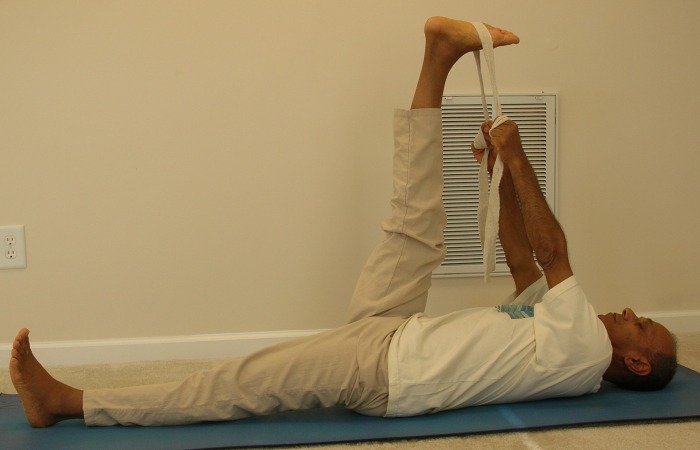In one of the previous articles, I talked about strength and how yoga helps us build strength at physical, physiological, mental and emotional levels. In today’s post, I would like to discuss one of the other commonly recognized benefits of yoga – flexibility. Again, we’ll be looking at how yoga can help improve flexibility at various levels.
 Parshvottanasana
ParshvottanasanaPhysical flexibility
When we talk of flexibility, most people identify it with flexibility at the physical level. That usually implies flexibility of various joints, muscle tissues, ligaments, skin etc. Most yoga asanas are intended to increase flexibility in all these areas. During the asana practice, we usually engage in one of these three types of movements:
Dynamic movement
In these movements, we move certain parts of the body in a constant movement, usually synchronized with breathing. For example, when we want to open the shoulder joints, we try to rotate the outstretched arm in a vertical plane. Repetitious movements in this manner help release tightness from the joints and associated muscles, thus improving overall flexibility.
Static movement (without a prop)
Here we try to stretch the muscles in a static manner and hold the asana for a certain length of time. For example, let us look at the hamstring stretching pose, Parshvottanasana. Here, as we slide the hands down the leg and, in the final position, try to drop the chest closer to the thigh, we begin to create a deep stretch of the hamstring area. When we hold the pose for some time, keeping in mind that we don’t overstrain, then the muscle tissues slowly begin to loosen up and tend to lengthen and strengthen the muscles.
 Leg stretch with strap
Leg stretch with strapStatic movement (with a prop)
Sometimes, when the muscles are too tight, it is desirable to use a prop to help maintain the static pose without feeling undue pain. For example, for stretching the back side of the leg, we usually do a reclining stretch using a strap. In the picture you can see that we are trying to stretch the leg up to a vertical position while holding the asana with the help of a strap.
We all know that with regular yoga practice, we are able to become more flexible – our joints tend to get loose, our muscles stretch and get longer and we begin to feel more comfortable in the poses that we practice regularly. However, the following factors can impact our ability to get more flexible:
- Bone structure
- An injury can severely limit range of motion and flexibility
- Age (older people can take longer to get flexible)
- In general, females tend to be a little more flexible than males
- Commitment and regularity of personal practice
Mental flexibility
I came across this passage online which seems to sum up nicely what mental flexibility is:
The essence of mental flexibility is the ability to handle different situations in different ways, especially to respond effectively to new, complex, and problematic situations. The mentally flexible person is able to:
- see things from several different perspectives
- tolerate ambiguity and uncertainty
- take risks willingly
- adapt to change
- learn from mistakes
- solve problems in new ways
- switch between practical and non-practical thinking.
— From the book "Humor Works" by John Morreall
Mental flexibility allows us to look at every new situation not as a threat but an opportunity to face the challenge and learn new things. Mental inflexibility is a result of our negative ego, not the pure intellect, influencing our decision-making process. Because the ego is always involved in the past or the future, it fails to understand the reality of the present moment and thus resists any kind of change.
Emotional flexibility
Emotional or psychological flexibility implies that we are able to quickly adapt to changing circumstances without letting our negative emotions take over. In the Hindu culture, six negative emotions are mentioned as "enemies of the mind". These are kama (lust/cravings), krodha (anger), lobha (greed), moha (delusion), mada (arrogance), and matsarya (jealousy). Any situation or event that does not correspond to our preconceived notion of being "good/acceptable" will evoke one of these negative emotions. These emotions become, in the final analysis, self-destructing as no good can ever come out from these emotional responses.
One of the commonly mentioned traits that can help stabilize the mind and prevent negative emotions is "acceptance" of things as they are. The popular "serenity prayer" can come in real handy in determining the course of action that we should take – "Grant to us the serenity of mind to accept that which cannot be changed; courage to change that which can be changed, and wisdom to know the one from the other".
In the Yoga Sutras, Patanjali defines yoga as "the ability to stay calm and peaceful in all situations and circumstances" (sutra 1.2). This definition tells us that the main purpose of the practice of yoga is to attain that level of physical, mental and emotional flexibility that will help us deal with the most difficult and challenging circumstances in life. A regular practice of all aspects of yoga that includes asana, pranayama, meditation, relaxation and contemplation can gradually lead us in that direction.
I just wanted to say Hi. I am a student of your Friday Am Library classes from the very beginning. I have moved back to NY, but wanted to say I am practicing yoga EVERY day! and I can feel the difference. Wow! Thanks for still sending your newsletter. Take care, Laura
Hi Laura,
It is so good to hear back from you. I am glad to see that you are able to practice on a regular basis and are enjoying the benefits of your practice. Yes, I fondly remember the times when you were either the only student in the class or one of the very few!
Stay in touch and take care!